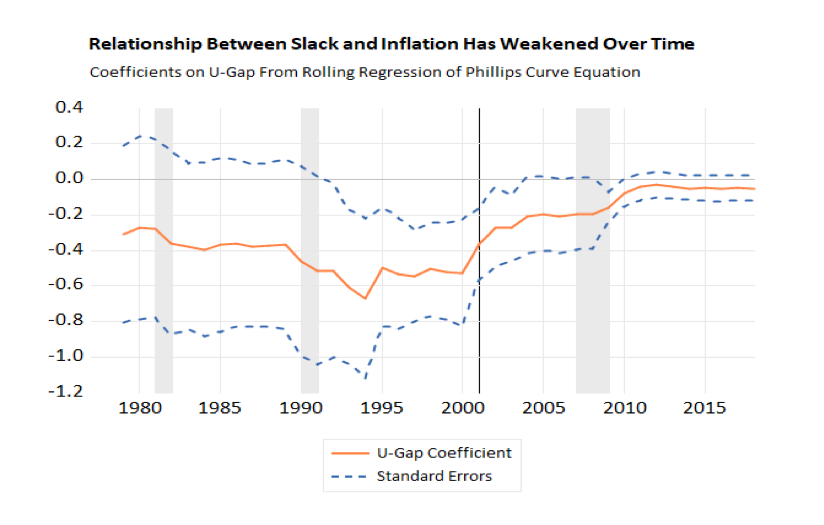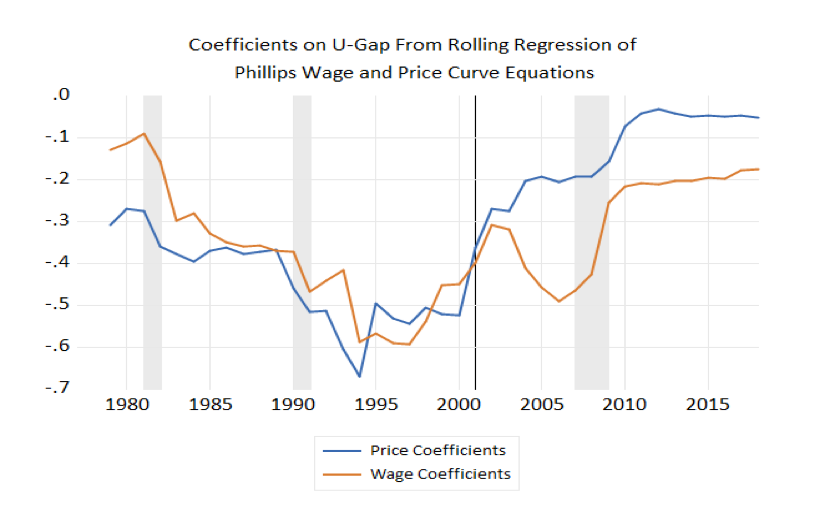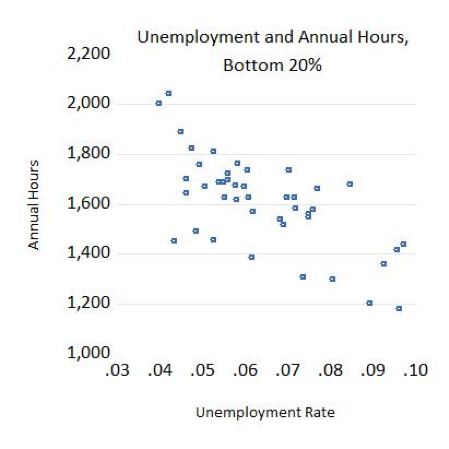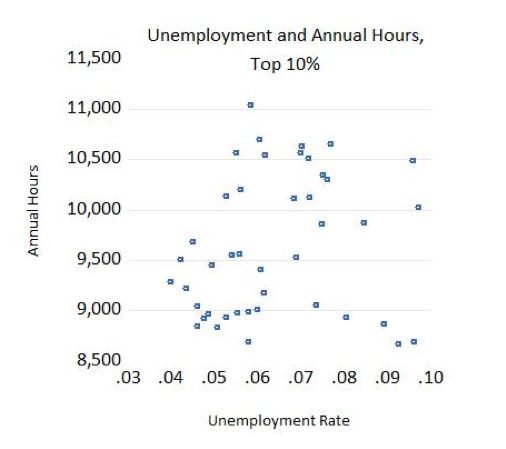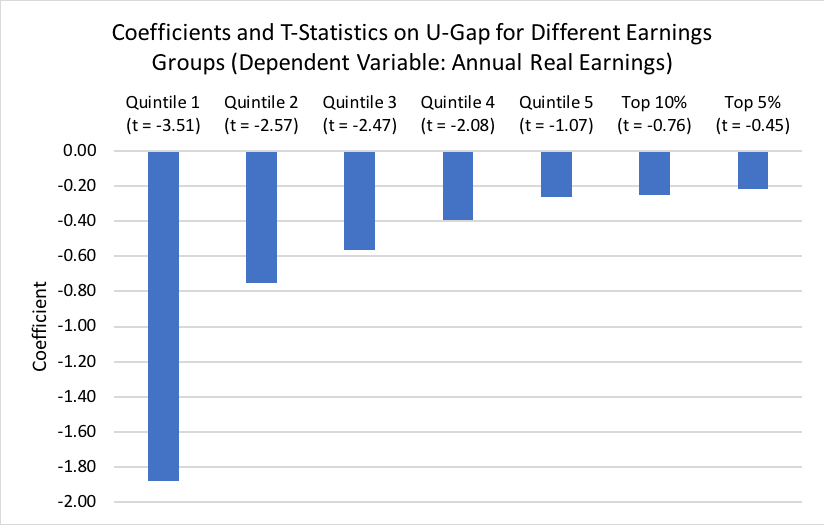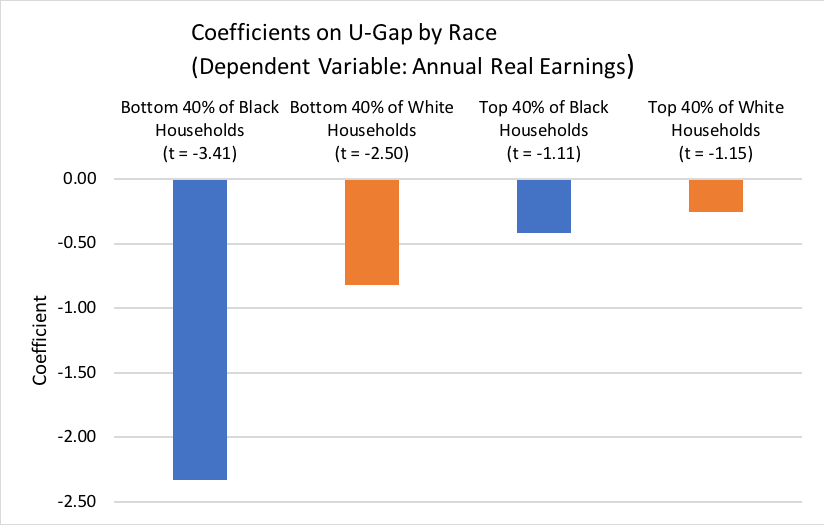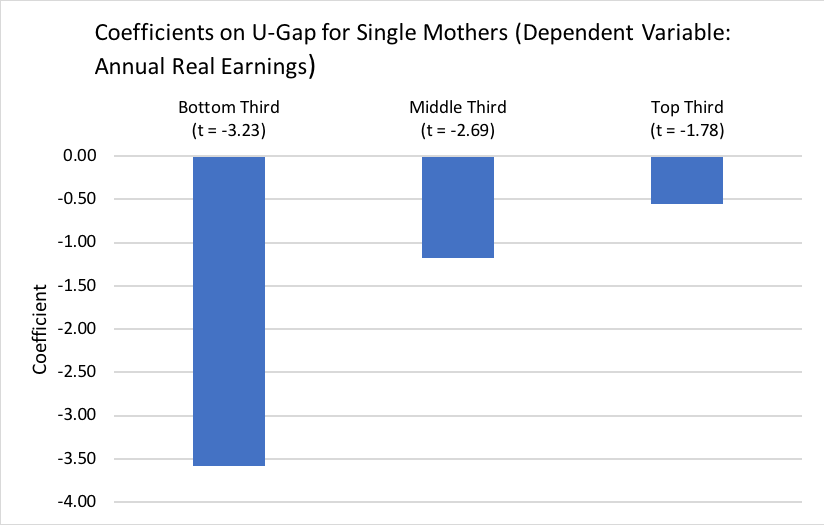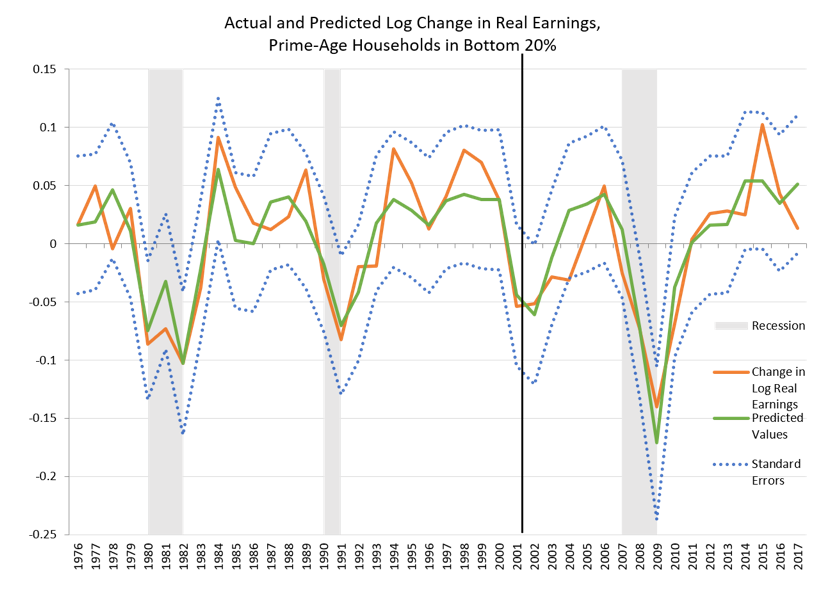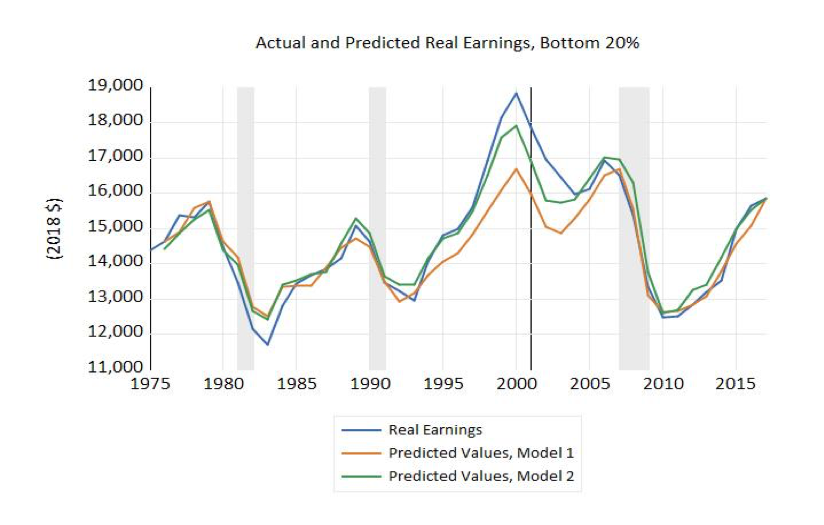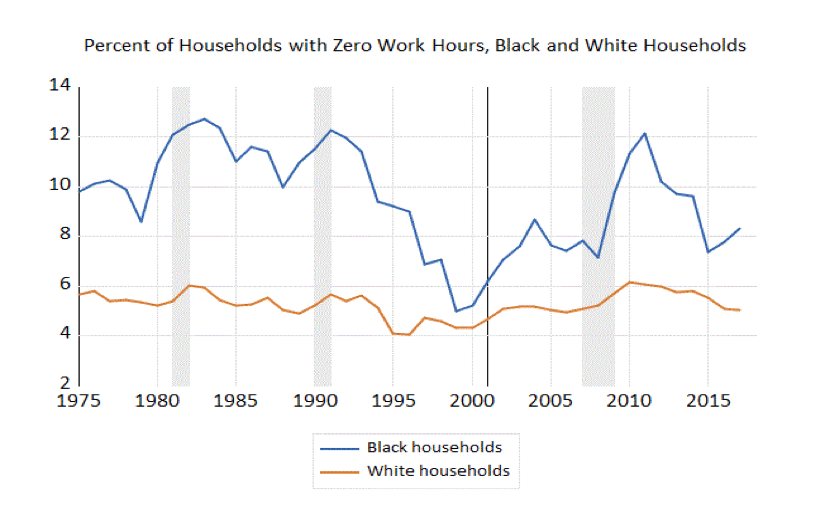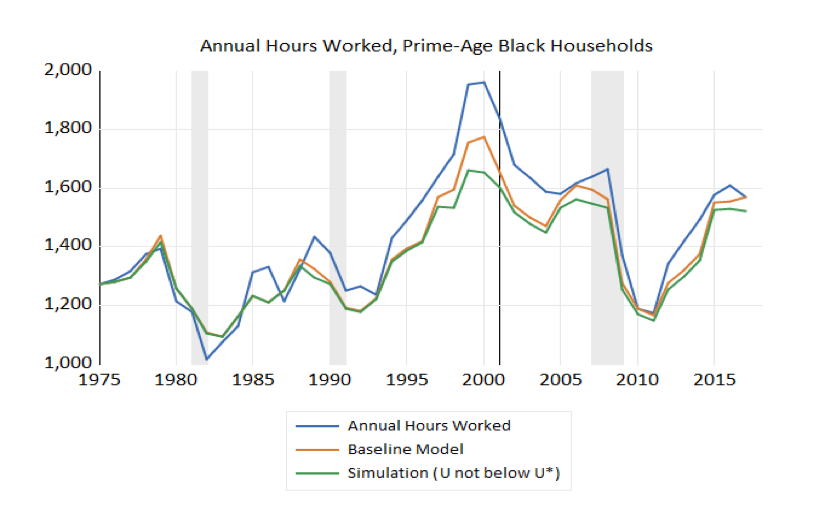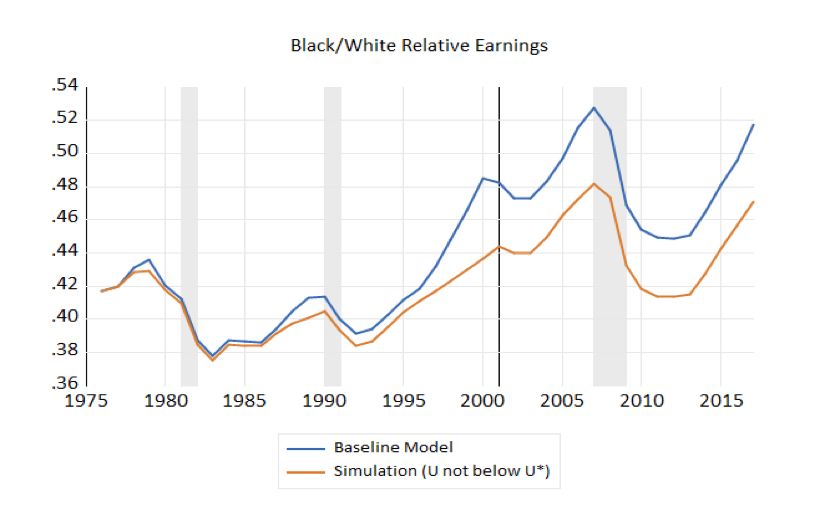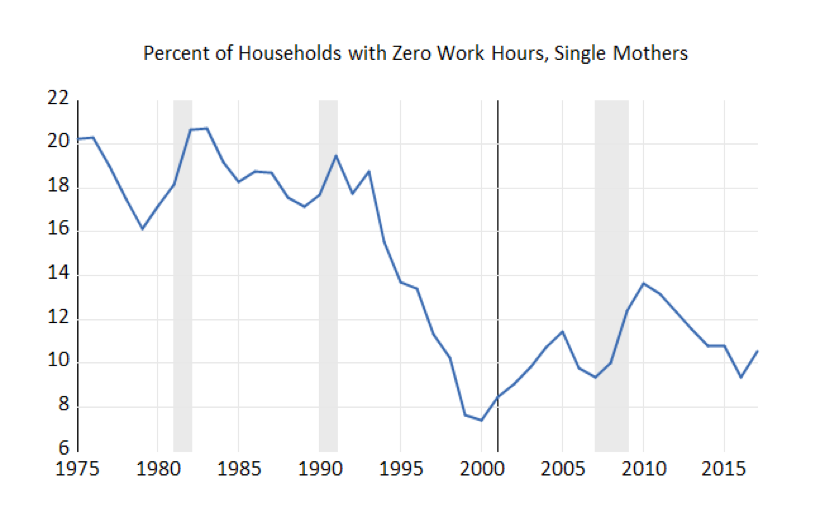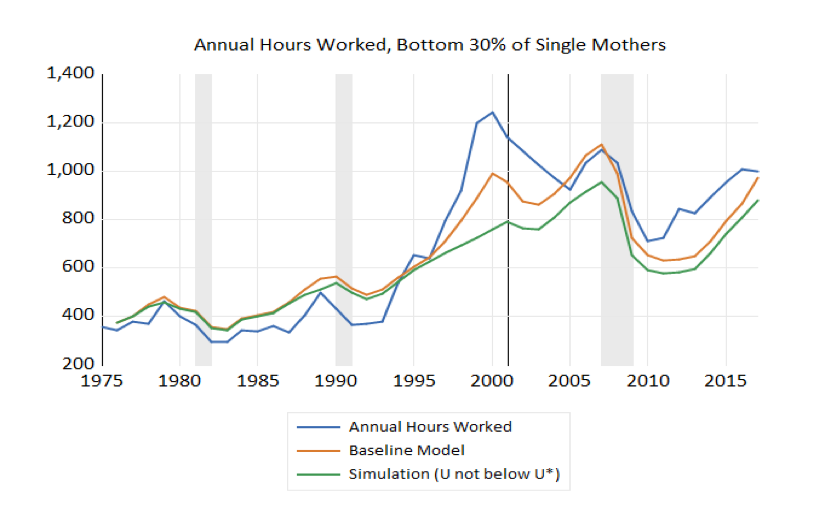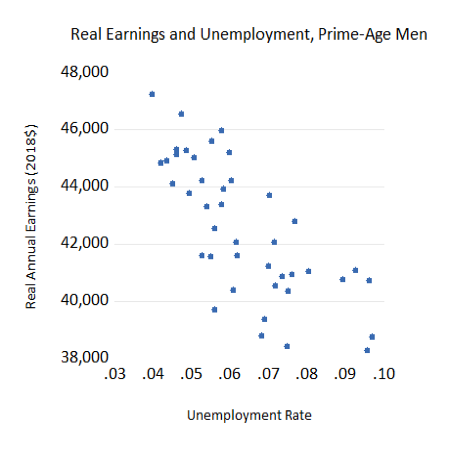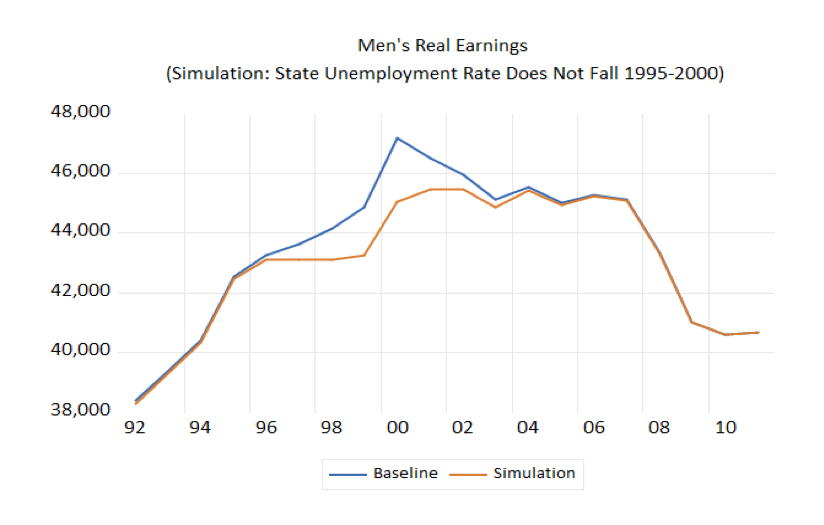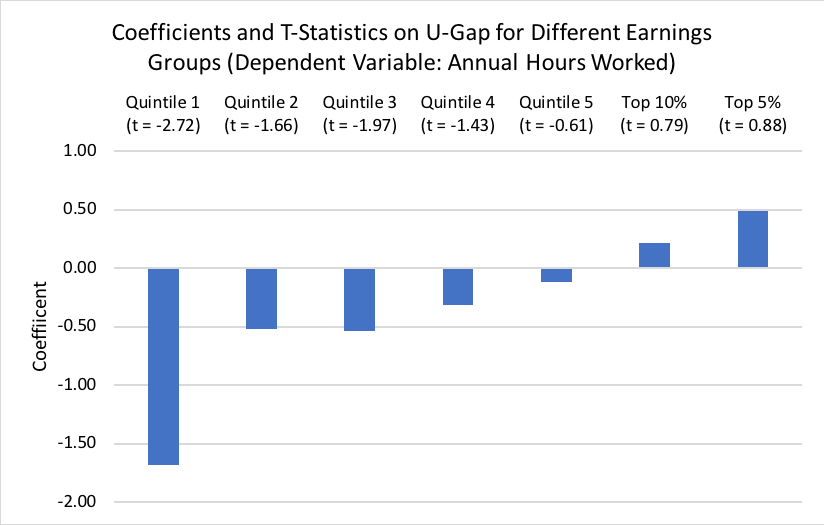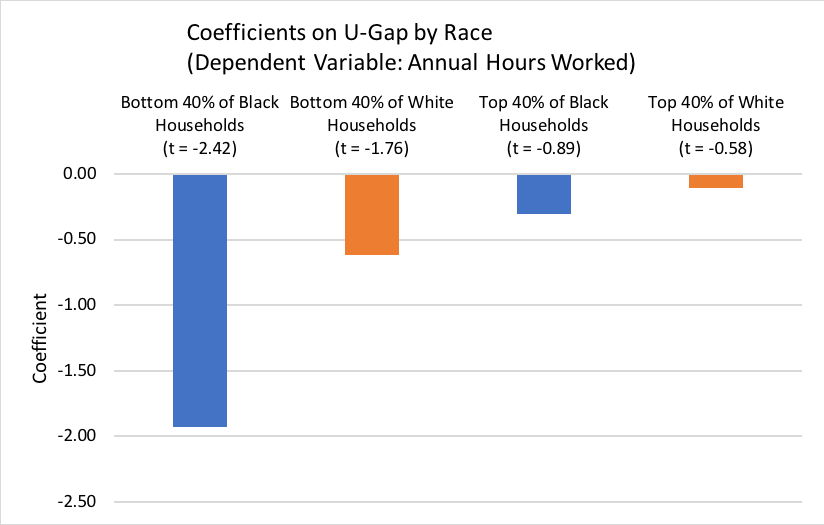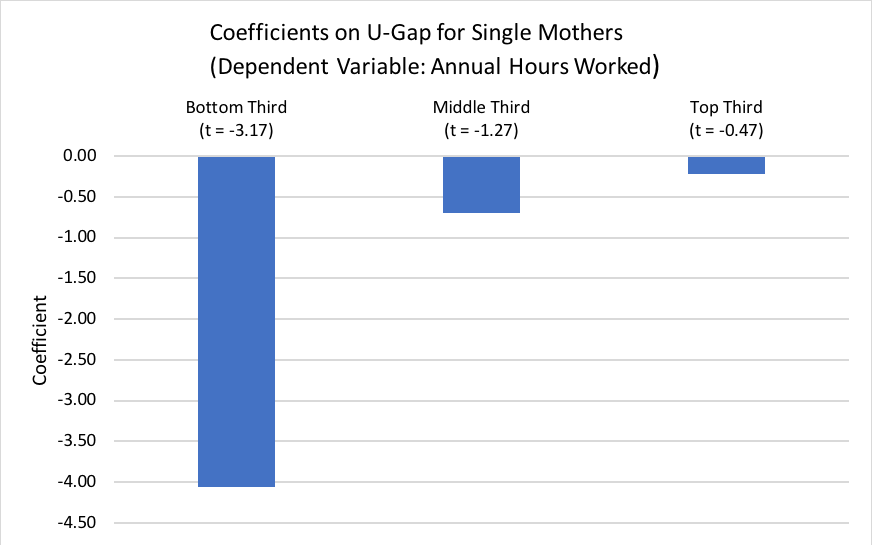- Home
- Full Employment
- The Increasing Benefits And Diminished C...
The Increasing Benefits and Diminished Costs of Running a High-Pressure Labor Market
Jared Bernstein and Keith Bentele[1]
This report was commissioned by the Center on Budget and Policy Priorities’ Full Employment Project. Views expressed within the report do not necessarily reflect the views of the Center.
Introduction
Since at least the days of Arthur Okun’s work on the “upgrading of workers into more productive jobs in a higher-pressure economy,” economists have recognized the benefits of tight labor markets, both to the macroeconomy and to disadvantaged groups.[2] Much literature, briefly reviewed below, shows persistent, low unemployment associated with nominal and real wage gains, most notably to lower- and middle-wage workers. Other work shows that groups with higher than average jobless rates, such as African Americans, benefit disproportionately from lower overall unemployment, and evidence presented in this paper shows these gains to be economically significant when looking at the impact of high-pressure labor markets not just on real earnings, but on labor supply as well.
From the perspective of the Federal Reserve, however, these outsized gains can come at the cost of inflationary pressures. In theory, such risks are heightened when the Fed allows the jobless rate to remain below estimates of the natural rate. But what if, as much analysis has shown, the correlation between inflation and labor market slack is diminished? Should the combination of the flatter Phillips Curve (PC) and the benefits of high-pressure labor markets — benefits that are particularly important in periods of high inequality and weak worker bargaining power — change the Fed’s weighting of the two sides of the tradeoff?
Our case thus begins by highlighting the structural decline in the slope of the Phillips Price Curve (PC) and the persistence of well-anchored inflationary expectations. This flattening introduces an asymmetry into the classic tradeoff: the inflationary costs of running a high-pressure labor market have come down relative to the labor market benefits. This asymmetry is partly a function of the weaker correlation between economic conditions and changes in inflation. But it is also a function of the equalizing nature of the benefits of maintaining full employment.
At the core of our argument is the idea that changing inflation dynamics, in tandem with higher wage, income, and wealth inequality, should create an asymmetry in the Fed’s reaction function, as such dynamics elevate the benefits of full employment and diminish the risks of inflationary pressures. Yet, in standard Taylor-type rules, a negative unemployment gap (unemployment below estimates of the natural rate) still leads to a higher funds rate. To be sure, many of today’s Fed officials, aware of these dynamics, do not subscribe to such automatic actions, but we argue that the evidence presented below suggests this thinking is still potentially and unnecessarily costly to economically vulnerable groups, and that negative unemployment gaps should get smaller weights.
The paper proceeds by documenting the diminished correlation between inflation and capacity measures, i.e. the flattening of the price PC and its relation to the wage PC. After a brief review of comparable literature, we present results on the benefits of high-pressure job markets and the costs of low-pressure ones. Our work here makes numerous contributions. First, we focus on different groups of households, including different income classes, family types, and races. Second, our units of analysis are broader than many other such studies: we examine annual earnings and hours worked summed across households. Third, we document the relatively large and economically important labor supply responses of certain groups of low-income workers to high-pressure labor markets. The effects are particularly important to single mothers and people of color. Our empirical analysis concludes using a panel data set to examine the impact of high-pressure labor markets on another group that has done relatively less well in recent decades: prime-age, non-college educated workers.
We then briefly comment on some other benefits of high-pressure labor markets and conclude with what we think our findings imply for the Federal Reserve as they consider new and improved ways to achieve their mandates. We note that while we do not offer a formal proposal to reweight a reaction function or Taylor rule in favor of sustaining persistent periods of very low unemployment, we believe that the thrust of our argument — that the reduced correlation between capacity changes and inflation lowers the costs of tapping the economically significant and equalizing benefits of persistently tight labor markets to less-advantaged families — is one with which many Fed officials already have some sympathy. A recent Wall Street Journal quote by Fed Vice-Chair Richard Clarida is, in this regard, germane to our argument[3]:
‘…the models that we consult are not infallible’…If they predict a surge in inflation, [Clarida] said, officials would need to weigh the benefit of pre-emptively raising rates “against the considerable cost of the model being wrong.
In what follows, we hope to elucidate one dimension of that “considerable cost.”
Inflation, Slack, Wages, and the Argument for Tolerating Lower Unemployment
In recent years, many economists have documented the flattening of the PC, the historically inverse relationship between some capacity measure — typically unemployment — and inflation. Charts like those in Figure 1a show up frequently in such analyses, using rolling regressions or the Kalman filter to allow for drift in the coefficients of a PC equation as structural correlations shift over time. For instance, Figure 1a shows the coefficient on capacity — in this case, u-u* or the unemployment rate minus an estimate of the natural rate, aka the “u-gap” — drifting toward zero, suggesting a flattening of the PC.[4] The coefficient on lagged inflation (not shown) drifts down, which is usually interpreted to mean less persistence in price movements and thus, increased anchoring of inflationary expectations around the Fed’s 2 percent target.
What about the wage PC? This is relevant to our work, because if the slope of that curve has also become indistinguishable from zero, then part of our case — running hot labor markets boosts earnings — is weakened.[5] Interestingly, while it too has drifted up, it has flattened less than the price PCE and it remains statistically significant. Figure 1b shows the same series of rolling coefficients from the price PC along with those from a wage PC equation.[6] Note the gap between the two series at the end of the series, along with the fact (not shown) that the t-statistics from the rolling regression for the PC curve are mostly insignificant starting around the mid-2000s while those for the wage PC are significant through the sample period. In other words, at least according to these simple regressions, slack is still a statistically significant determinant of nominal wage growth as opposed to price growth.
There are various counterarguments to the idea that a flat price PC provides a rationale for the central bank to run higher-pressure labor markets than would otherwise be consistent with their mandate.
First, some research finds the contemporary PC has more of a slope than shown toward the end of Figures 1a. Ball and Mazumder, for example, find evidence for a steeper PC using filtered inflation measures.[7] Gagnon has documented non-linearities in PC’s, showing the curve activates at higher levels of inflation than have been the norm in recent years.[8] Goldman Sachs researchers find that while the national data yield results like those shown in Figures 1a and 1b, negatively sloped PCs are alive and well at the metro level.[9]
Second, there exists considerable uncertainty as to what drives inflation in recent years, raising questions as to how important or lasting is the flattening shown in Figure 1a, especially given that even in periods when the price PC was steeper, slack rarely explained more than a fifth of the variance in inflation. By running our price PC model from 1959-1995 and isolating the contribution of the u-gap, we find it explains 20 percent of the variance in inflation. Since 1995, that drops to 4 percent.[10] Thus, it would be a mistake to over-emphasize the importance of the flat price PC and the diminished role of slack in predicting future inflation, as we just don’t have a reliable sense of what’s driving contemporary price movements.
Therefore, we neither dismiss the findings of steeper price PCs, nor do we argue that the drift toward zero in Figures 1a will never reverse, or that that inflation/slack relationship is the key determinant of price movements.
But for the foreseeable future, we think the weight of the evidence points toward asymmetric risk, with insufficient demand a greater risk than accelerating spiraling inflation. After all, one thing we do know about inflation is that while unemployment spent years above conventional estimates of the natural rate, core inflation flitted about 2 percent. Now, u has spent a few years below u* and inflation still flits about 2 percent, with years of downside misses to the 2 percent target. Thus, not only do the inflationary risks of high-pressure labor markets appear to be low. The risk of persistently below-target inflation may be more threatening to the central bank than that posed by unemployment persistently below the bank’s estimate of u*.
We think this counterintuitive finding may not provide optimal guidance for monetary policy, particularly from the perspective of less-advantaged workers. If, as both we and these authors agree, the PC is flat, then faster or slower inflation must not be a function of looser or tighter capacity but due to a supply shock, a point with which Erceg et al. agree:
…the notion that policymakers should downweight the unemployment gap and compensate, in some sense, by responding more aggressively to inflation is substantially weakened in the empirically-relevant case in which the Phillips curve is relatively flat and inflation is buffeted by sizable “supply,” or cost-push, shocks. Under these conditions, reacting strongly to inflation tends to induce a high degree of volatility in the (true) unemployment gap. Moreover, in the current environment, with unemployment already quite low, an aggressive response to inflation when it is below target could increase the likelihood that the unemployment rate falls to historically low levels with attendant risks…to the sustainability of macroeconomic outcomes.
One source of confusion is what constitutes a “sizable” supply shock and whether it would have a lasting impact on inflation. Given well-anchored inflation and a communicative Fed, temporary shocks, whatever their magnitude or direction, are not a good reason for the Fed to respond “aggressively,” versus seeing through the shock and explaining their actions to markets. Lasting supply changes — a persistent shift in the productivity growth rate, for example — are a different story.
Second, their simulations show that if u* is considerably lower than the Fed currently believes to be the case (i.e., 3.7 versus 4.4 percent),[12] there is virtually no welfare cost to targeting the inflation, versus the unemployment, gap.[13] This result holds even with loss or response functions that give no weight to the costs of higher unemployment on the groups with lower incomes. Periods with u below an over-estimated u* — and we think the inflation evidence of recent years supports the case that u* has long been overestimated — disproportionately help those with the lowest earnings, a benefit not considered by conventional loss functions.
Thus, given:
- the economically large (as shown below) magnitude of these benefits to real earnings and hours worked;
- well-anchored inflation that appears quite unresponsive to capacity gaps;
- actual u* likely lower than the central bank’s estimates of u*;
- and the Fed’s need to see through and communicate the impacts of temporary supply shocks (while maintaining the inflation anchor),
we think the weight of the evidence supports monetary policy that reflects asymmetric risk as defined above.
Prior Findings on the Benefits of Low Unemployment to Economically Vulnerable Groups
Since the aforementioned Okun paper, there was not a lot of literature on the impact of high-pressure labor markets until the conclusion of the full employment period of the latter 1990s. Since then, however, considerable research has appeared.
Bernstein and Dean Baker’s book, The Benefits of Full Employment, develops empirical arguments much like those in the next section, along with a critique of the relatively high estimates (with large standard errors) of the natural rate at the time (around 6 percent). Katz and Krueger begin their paper on the “High Pressure US Labor Market of the 1990s” by observing that u was well and persistently below u* but that inflation had decelerated.[14] They then document some of the benefits of the high-pressure expansion to less advantaged workers.
Mericle and Thakkar examine high-pressure episodes in the U.S. labor market looking for evidence of two effects: improved supply-side outcomes (structural versus cyclical, increases in labor supply and/or productivity) and benefits to less-advantaged workers.[15] They find less evidence of the former effect (see the discussion of reverse hysteresis, below) but some evidence of the latter. For example, they find periods of low unemployment to be correlated with higher probabilities of re-employment for the long-term unemployed.
A recent paper by Bernstein for the Brookings Hamilton Project shows that by conventional measures of u*, the U.S. job market has suffered some degree of slack for about 70 percent of the time since 1980. The paper shows that persistent periods of u>u* are associated with significant negative impact on wages and incomes, with these costs falling disproportionately on the least advantaged.[16]
A recent, similar analysis by Bivens and Zipperer (BZ) examines the impact of changes in unemployment on real wage (and hours) growth for different groups.[17] For example, using a panel data set of states from 1979-2016, they find that a 1 percentage point (ppt) decline in unemployment raises 10th percentile real wages by about 0.5 percent, median real wages by 0.4 percent, and 90th percentile wages by 0.3 percent. BZ’s results for annual hours worked by race are also consistent with our emphasis of the equalizing impacts of low unemployment. They find, for example, that for African American households a percentage point decline in unemployment raises annual hours by 2.7 percent. In our data, annual household work hours (summing across prime-age households) of middle-quintile, black households rose 12 percent from 1992-2000, as the (overall) unemployment rate fell 3.5 ppts (from about 7.5 to 4 percent). Using BZ’s coefficient implies that falling unemployment accounts for 77 percent of those increased hours, a powerful example of the impact of the 1990s high-pressure job market on the work hours of black households.
Sticking with the benefits of high-pressure labor markets to people of color, a recent paper by Federal Reserve researchers finds that for every ppt reduction in the output gap, the black-white unemployment gap (black u – white u) closes by about half a percentage point, a finding that roughly comports with the last recession, when the output gap grew by about 6 points and the black-white unemployment gap went from around 4 to almost 8 points.[18] In a finding that speaks to hysteresis concerns we raise below, the study finds that job loss is lasting and costly for blacks and Hispanics, because, relative to whites, it can take them longer to get and stay in the labor market, a dynamic that helps explain the lasting damage imposed on workers of color by periods of weak labor demand.
We now add to those findings with new evidence of the benefits of high-pressure labor markets on various low-income groups.
The Impact of Low Unemployment on Annual Earnings and Labor Supply for Low-Income, Working Age Households and Individuals
In this section, we use descriptive statistics, simple time series, and state panel models to document the benefits of full employment to less-advantaged households. While much of the above research analyzed the fundamental building block of living standards for working-age households — the real, hourly wage — we focus on real annual earnings, or the product of real hourly pay and annual hours. While this introduces clear endogeneities — in high-pressure labor markets, earnings and hours are endogenous to labor demand — we find that simple models provide insight into the role played by unemployment in the real earnings of lower-income, working-age households.
Moreover, as suggested in the earlier work reviewed above, the explanatory power of the models falls as incomes rise, meaning elasticities of annual real earnings with respect to labor market tightness are relatively high for less well-off groups. Our models also find economically important elasticities for lower-income groups associated with annual hours worked. By providing disproportionate earnings and hours gains for the least advantaged, maintaining high-pressure labor markets drives both absolute and relative gains for many working households.
Data
For the time series analysis that follows, all income, earnings, and work hours estimates are based on data extracts drawn from the Annual Social and Economic Supplement of the Current Population Survey using the IPUMS – CPS database.[19] We generated national estimates of average total household income, earnings, and work hours within quintiles and for the top 10 percent and top 5 percent of households[20] for the years 1975-2017. We also estimated the proportion of households in each group with no annual labor market earnings. Quintiles and deciles were determined using total household income from all sources. The sample was restricted to households in which the household head (and spouse if present) are prime age, ages 25 to 54, and the sample excludes any households with negative income or those with no earnings in which the household head was not working due to disability or illness. We should note that otherwise we include households with no labor income in our sample. Using this sample, we generated estimates of these various income and labor market participation variables for all households and for various subgroups of interest. We examine trends for households in which the household head is identified as African American, for households with single mothers[21] as household heads, and for prime-age workers. Due to smaller sample sizes, for African American households, we analyze the bottom and top 40 percent; for the same reason, for households headed by single mothers, we examine average household characteristics within thirds of the household income distribution.
For our state-level panels, we extracted separate samples of prime-age men and women without a college education (individuals who either lack a bachelor’s degree or had less than four years of college) excluding those not working due to disability or illness. Using the CPS ASES data, we estimated average earnings, work hours, age, years of education, the percent with $0 labor earnings, and the percent white, for each state for the years 1976-2017.
In addition, we compiled the following control variables for these analyses: state minimum wage rates, state union density, and state employment in manufacturing. State union density is an estimate of the percentage of employed workers who are union members constructed by Hirsch & MacPherson (2003) based on CPS data.[22] Our measure of state manufacturing employment is the percent of nonfarm workers employed in manufacturing based on data from the Bureau of Labor Statistics.
Annual Earnings and Hours Worked for Different Groups
The next two figures motivate much of what follows. Figure 2 plots real annual earnings for the first quintile using all prime-age households in the sample described above along with the unemployment rate, and the inverse relationship between the two variables is apparent. Figure 3 replaces the bottom fifth with the top tenth in real earnings. The lack of a clear relationship is evident in the scatterplot.[23] Our own regressions and those cited in the previous section (e.g., from BZ’s work) show that while slack measures are correlated with earnings for most wage groups, they are much more so for those with relatively lower wages.
It is revealing to observe these same bivariate relationships with annual hours worked (as with earnings, summed across households) replacing incomes, again for the bottom fifth of earners and the top 10 percent, as shown in Figures 4 and 5. The results are perhaps even more evident of the tight relationship at the bottom and the weaker one at the top.
Such a gradient is evident in the next few figures, which show the coefficient on the “u-gap” from regressions of the log change in real annual earnings on the u-gap. Below, we show these coefficients for all households (Fig. 6), black households (Fig. 7), and single mother households (Fig. 8). In every case, the change in the u-gap correlates (negatively) more strongly with earnings of the least well-off groups. Figure 7 reveals that the u-gap elasticity for low-wage, African American workers is significantly larger than that for low-wage white workers, suggesting the high-pressure labor markets can reduce racial earnings gaps (the difference is significant at the 0.001 level).
Figures A1-A3 showing the coefficient on the u-gap from regressions of the log change in hours can be found in the Appendix. Once again, the change in the u-gap produces larger gains in hours worked for low-income workers, especially low-income Black workers and low-income single moms, than for higher-income workers. For example, Figure A3 shows that the u-gap hours coefficient for low-income single moms is -4.1 with a t-stat of -3.2. From 2007-10, in the Great Recession, the cumulative change in u-gap was about 5 percentage points. Multiplied by the coefficient, this change predicts about a 20 log-point decline in annual hours for low-income single mothers, a bit more than half of the actual magnitude that occurred in those years, as their annual hours fell from about 1,100 to about 700. As the t-statistics show, for higher income groups, the coefficient is sometimes statistically insignificant.
Differences in Earnings Growth Between High- and Low-Pressure Labor Markets
The next descriptive tables show average annual log changes in real annual earnings across distributions for all, black, and single-mother households for three time periods: the full sample, high pressure (HP), and low-pressure (LP) labor markets, with the former defined as u<u* and the latter arbitrarily defined as u>(u*+.015); thus, if u*=5 percent, LP is any year with u>6.5 percent. Real earnings for all low-income (bottom 20 percent) households grew just 0.2 percent (.002 log points) per year, compared to 2.3 percent for the top 5 percent. But in HP labor markets the growth rate for Q1 was 10 times faster: 2.3 percent per year. To gauge the equalizing impact of moving from LP to HP labor markets, the bottom row shows the acceleration in earnings from going from LP to HP labor markets (HP-LP). For all Q1 households, the swing from HP to LP is 6.1 percent average annual growth, compared to 0.002 to top 5 percent households.
The next table compares earnings’ growth rates for low-income black, white, and single mother households. In HP labor markets, low-income black earnings grew by 3.7 percent per year, more than four times the rate for low-income white households, underscoring the findings cited in the literature review on how HP labor markets help close racial earnings gaps. The swing for LP to HP leads to a large acceleration in black earnings: 7.9 percent per year, a rate far higher than that for either low-income white households or higher-income black households. HP labor markets are particularly important for low-income single mothers in our sample, with average growth rates of 8.1 percent per year. Conversely, weak labor markets are extremely costly to them. Thus, the swing from LP to HP is 13 log points, compared to about 2 for single-mother households in the top-third of the income scale.
| TABLE 1 | |||||||
|---|---|---|---|---|---|---|---|
| Average Annual Log Growth Rate in Real Earnings, 1975-2017: All Households | |||||||
| Quintile 1 | Quintile 2 | Quintile 3 | Quintile 4 | Quintile 5 | Top 5% | Top 1% | |
| All Years | 0.002 | 0.003 | 0.005 | 0.008 | 0.016 | 0.019 | 0.023 |
| High Pressure Labor Markets | 0.023 | 0.009 | 0.007 | 0.012 | 0.012 | 0.011 | 0.009 |
| Low Pressure Labor Markets | -0.039 | -0.013 | -0.009 | -0.002 | 0.005 | 0.006 | 0.007 |
| High Pressure – Low Pressure | 0.061 | 0.022 | 0.017 | 0.013 | 0.007 | 0.005 | 0.002 |
Source: CBPP Calculations using CPS Data.
Note: All years, n = 42; HP n = 13; LP n=8
| TABLE 2 | |||||||
|---|---|---|---|---|---|---|---|
| Average Annual Log Growth Rate in Real Earnings, 1975-2017: All Households | |||||||
| Bottom 40% of Black Households | Bottom 40% of White Households | Top 40% of Black Households | Bottom 30% of Single Mothers | Top 30% of Single Mothers | |||
| All Years | 0.009 | 0.004 | 0.010 | 0.023 | 0.017 | ||
| High Pressure Labor Markets | 0.037 | 0.008 | 0.011 | 0.081 | 0.020 | ||
| Low Pressure Labor Markets | -0.042 | -0.014 | -0.001 | -0.049 | 0.002 | ||
| High Pressure – Low Pressure | 0.079 | 0.022 | 0.012 | 0.130 | 0.019 | ||
Source: CBPP Calculations using CPS Data.
Note: All years, n = 42; HP n = 13; LP n=8Time Series Regressions: Predicted vs. Actual
We create two models to back out more quantitative information on the magnitude of the underlying relationships between annual earnings, unemployment, and cyclical changes in labor supply. Our simple model (referred to subsequently as “Model 1,”) regresses the change in log of real, annual earnings for all prime-age households in the first quintile against the log of unemployment, and the log change (to capture any non-linearities, such as accelerated earnings growth at very low unemployment).[24] The results for this regression can be found in the Appendix (Table A1).
Figure 9a shows that the fitted values for Model 1 track the actual series fairly closely with just these two regressors, though, as is common in our models, the prediction undershoots the strong gains of the latter 1990s.[25] Also, the standard error bands show a fairly wide forecast error around these predictions such that many of our forecasts and simulations have wide confidence intervals around them. For example, in 2000, the actual real gain for this group was a log change of 3.8 points; the model predicts 3.7 log points, but 2 times the standard error runs from -9 log points to +2 log points. Thus, our simple models quite impressively capture the dynamics of complex series, but with few data points, our standard errors are often wider than the differences in our simulations. Below, we run panel models with many more observations and tighter error bands.
The sum of the unemployment coefficients is -0.36, meaning that a 10 log point decline in log unemployment would raise real annual earnings by 3.6 percent, or over $500 at the mean in our data (2018 dollars, using the CPI-RS deflator). The large fall in unemployment in the 1990s noted above (7.5 percent in 1992 to 4 percent in 2000) contributed to a 35 log points increase in earnings in those high-pressure years, or an historically strong annual growth rate of 4.4 percent, 1992-2000. Based on the simple model, falling unemployment explains 26 log points of the change in earnings, or about 70 percent of the total change.
However, labor supply increases were also important over that period. While hours and earnings are both endogenous to slack, [26] we create a second model (“Model 2”) that adds the log change in annual hours to the parameters of Model 1. As shown in Figure 9b, adding the log change in annual hours worked creates a better fit and closes part of the gap between the predicted values and the real earnings series. Furthermore, we can see how far Model 2 “knocks down” the sum of the unemployment variables (in this case, from -0.36 to -0.20). One interpretation of this difference is that increased labor supply explains just less than half of the impact of unemployment on the real earnings of low-wage households.[27]
Figure 10 shows the results of Model 1 and Model 2 for (prime-age) African American households, using the average of the bottom two quintiles (the bottom 40 percent, by income) to smooth out some noise due to smaller sample sizes. Once again, the predicted series tracks the actual, with the 1990s undershoot in model 1 (the log change in real earnings regressed on log unemployment and the change in log unemployment), reduced by including the log change in annual hours for the bottom 40 percent (model 2).
The coefficients on unemployment in model 1 sum to -0.41 compared to just -0.15 in model 2, implying that increased labor supply (itself endogenous to falling unemployment and rising earnings) explains over 60 percent of the impact of low unemployment on the earnings of low-income African American households. In two periods of sharply falling unemployment over our data series, the real earnings gains were relatively (to other groups) large: the latter 1990s and the recent period, from 2010 to 2017. In the first period (1992-2000), real earnings grew 59 log points (about 7 percent annually); in the second period, 30 log points, or about 4 percent annually.
It is notable from the Fed’s perspective that the decline in unemployment in the 1980s did not lift black household earnings much at all, despite the fact that its delta in ppts was similar to that of the other expansions. This likely has to do with fast-growing disparity of relative and absolute wages in those years[28] as well as non-linearities that kick in only in high-pressure labor markets (u persistently below u*). The presence of such non-linearities underscores the cost to less advantaged groups of overestimating u* in monetary policy guided by Taylor-type rules, especially those with larger coefficients on the u-gap than the inflation gap.[29]
Given hours’ endogeneity to labor market demand, we next take a closer look at changes in annual hours. To get a sense of the magnitude of hours’ responsiveness to changes in demand, Figure 11 shows the share of black and white households (all, not just the bottom 40 percent) with zero hours of work. Our simple analysis leaves out important factors that influence the different levels and trends of these two variables, most notably racial discrimination and education differences. Even so, the figure shows that African American prime-age workers are particularly elastic to high-pressure labor markets, in this case along the extensive participation margin, making it an important factor for both a central bank trying to better understand the dynamics of labor market capacity and for families of color trying to get ahead in more welcoming labor markets.
Figure 12 shows the results of a regression of logged annual hours for prime-age, black households in the bottom 40 percent on log unemployment (in levels and changes) along with the lagged dependent variable. Once again, the fit is good as the baseline model tracks the actual results fairly well. In order to quantify the importance of the 1990s high-pressure labor market, we also simulate the impact on hours if u was not allowed to fall below the CBOs u* (one definition of a high-pressure labor market is a lasting period wherein u<u*). For example, this rule imposes u=5.2 percent (CBO’s natural rate that year) instead of 4 percent in 2000 (the actual rate). Figure 12 shows the simulated line, which, by construction (given the negative coefficients on unemployment and the models feedback through the lagged DV) runs below the baseline in high-pressure periods. Accumulating the hours lost under the simulation (relative to baseline) in one high-pressure period, 1992-2000, amounts to almost 600 hours. At the average real wage over those years, that’s a loss of almost $6,000 (2018 dollars) for a group whose income averaged about $20,000, 1992-2000 (though, under the simulated rule, real wages and incomes would have also been lower, of course). In 2000 alone, the simulation reveals a loss of over 200 hours, at a real wage of about $10 that year.
Turning briefly to relative gains, Figure 13 shows that black relative (to whites) earnings also respond to unemployment as, according to coefficient in Table A1, a 10 log point decline in unemployment reduces the gap by about 2 percent. Running the same simulation as above (u never below u*), finds that the baseline relative earnings ratio (black to white) rose 9 ppts from 1992 to 2000; under the simulation, they rose 6 ppts, implying that a third of the gap closure was due to this simulated definition of a high-pressure labor market in those years.
Turning to single-mother families, where we focus on the lowest income third, Figure 14, model 1, shows that the baseline model significantly underpredicts the dramatic earnings gains for this group in the latter 1990s. Between 1993 and 2000, real annual earnings for this group grew a remarkable 16.6 percent per year. Given that this was a high-pressure period, with u<u* — between 1995 and 2000, u was a cumulative 3.2 percentage points below CBO’s u* — it is worth devoting some significant analysis to the dynamics of this series.
Model 2 reveals how important the increase in labor supply was for this group, as Model 2, which adds the log change in annual hours worked, not only clearly improves the fit, but the inclusion of the hours variable makes the unemployment variables statistically insignificant, more evidence of the strong endogeneity of hours worked.
Figure 15 shows the historically large decline in the share of all single-mother households (not just the bottom income third) with zero hours of work. Much research has explored the sharp 1990s increase in labor supply of this group, assigning it to the expansion of the Earned Income Tax Credit, the increase in the federal minimum wage, and the impact of the 1996 welfare “reform” law, which included work requirements. The “pull” of uniquely strong labor demand for lower-wage workers was met with “push” factors on the supply side, including welfare-to-work requirements/time limits and substantial EITC and minimum wage increases.[30]
As annual hours worked by low-income single mothers are also a function of unemployment, in Figure 16 we regress the logged annual hours on unemployment (logged and log changes) and the lagged dependent variable. Though the coefficients reveal a significant elasticity (-0.66, meaning a 10 log point decline in unemployment raises annual hours for this group by just under 7 percent), the figure shows that the model is too parsimonious to capture impact of the other factors noted above that also contributed to the growth of annual hours for single mothers in the 1990s.
Even so, based on the significant unemployment elasticity, we can simulate alternative unemployment scenarios to gauge the impact on hours and earnings for low-income, single-mother families. For example, consider the cost to these households of the same no-high-pressure rule modeled above (u never below CBO’s estimate of u*). Over the full series, this accumulates to a loss of 2,300 hours (see Figure 16). In the year 2000, the difference between our baseline hours estimate and the simulation is about 230 hours. The average hourly earnings for this group that year was about $9.30 (2018 dollars), suggesting that the costs of enforcing u* in that one year would have been almost $2,100, about 13 percent of the average income of the bottom third of such households in 2000.[31]
Prime-Age, Non-College Educated Men and Women: Panel Data Analysis
To both generate more observations and examine another group with both political and economic relevance, we now turn to similar analyses for prime-aged, non-college educated workers (PANC), looking at men and women separately.[32] Figures 17a and 17b plot scatterplots of real, annual earnings and unemployment for both genders. The plot, especially for men, reveals the familiar inverse correlation with unemployment, though as has been well documented, men’s earnings grew very slowly over these years: in our data, real annual earnings rose only about 5 percent over these years (1976-2017), about 0.1 percent per year.
As has been shown in many analyses, PANC women (and women workers overall) have experienced more positive, secular trends than men, in part due to industry shifts away from production work towards services (note their less-tight fit in the scatterplot). Their annual earnings almost doubled, up 1.6 percent per year over the full period. However, since 2000, women PANCs have seen no real gains in annual earnings.
Turing to fixed effects regressions, we regress state/year observations of the change in log real earnings on the log of state-level unemployment. Results in Table A2 show that the coefficient on unemployment for men PANC is significant and suggests a 10 log-point decline in unemployment is associated with a 0.34 percent rise in real earnings.[33] Revealingly, adding controls for manufacturing share, white share, average years of education, and unions have little impact on the unemployment elasticity. Clearly, labor demand matters to the earnings of this group of men. The unemployment coefficient for PANC women is, as expected given their structural gains, below the one for men.
Because states have very different unemployment levels, using the national u* for our earlier simulation (u never below u*) makes less sense in this state panel context. Instead, we again take advantage of the latter 1990s as a period of uniquely low unemployment. Using our fixed effects models, for each state, we hold state unemployment fixed at its 1995 level from that year through 2000. Thus, our simulation tries to capture the impact of a period of national high-pressure labor markets in each state on PANC workers, even if that state’s unemployment rate never fell below u*.
Figure 18 shows the results of the simulation on real, annual earnings for male PANCs by plotting the real percent difference between the baseline and simulated models. By 2000, the impact was -4.5 percent, or $2,100 in 2018 dollars. Between 1995 and 2000, baseline real earnings rose 11 percent (the same as actual earnings). Simulated earnings rose only 6 percent, suggesting that about 45 percent of the earnings gains in those years were a function of high-pressure labor markets, conditions that were, in turn, a function of uniquely patient Fed monetary policy as the jobless rate fell well below estimates of the natural rate at the time. We note that the core PCE averaged 1.7 percent over those years.[34]
Results for PANC women are of very similar magnitudes. Because their annual earnings levels are about half those of men, however, the difference in real 2018 dollars between the 2000 simulated and baseline earnings was about $1,000, but at -4 percent (relative to baseline), this is still close to the male results in percentage terms. Comparing baseline and simulated earnings suggests the high-pressure labor market explained one-third of women’s gains, 1995-2000.
As with the time-series results above, changes in labor supply were an important determinant of annual earnings for PANCs, especially for women. Figure 19 shows the annual share of PANCs with zero hours, by gender. Little variation is evidence for men, but the share of women with zero hours worked fell by half from the mid-1970s through 2000. In fact, when we add logged annual hours to the women’s earnings equation, the unemployment coefficient flips to the “wrong” sign (positive) and is insignificant.[35]
Summarizing, the benefits of high-pressure labor markets can be observed both in terms of earnings and hours. Our simple models often assign over half of the gains in real earnings for the groups we analyze to high-pressure labor markets, both through earnings and hours channels. For these groups, persistently tight labor markets lead to the cyclical decline in the share with zero hours worked and gains in annual hours worked. For both low-income African Americans and single mothers, hours gains explain more than half of their earnings gains. In other words, while earlier research showed clearly that high-pressure labor markets creates upward pressure on real hourly earnings, our findings, like those of BZ, also show the economically significant contribution of high-pressure labor markets to hours worked, a factor that should contribute to “room-to-run” dynamics for the Federal Reserve even, or especially, when u<u*.
Other Potential Benefits of High-Pressure Labor Markets
The previous section showed the cyclical benefits of periods of high-pressure labor markets on the real earnings and hours of economically vulnerable groups of workers. In this section, we briefly discuss two other supply-side benefits of high-pressure labor markets: reverse hysteresis and faster productivity growth.
In a 2016 speech, Former Chair Yellen recognized potential linkages between high-pressure labor markets and reverse hysteresis: “If we assume that hysteresis is in fact present to some degree after deep recessions, the natural next question is to ask whether it might be possible to reverse these adverse supply-side effects by temporarily running a ‘high-pressure economy,’ with robust aggregate demand and a tight labor market.”[36]
While evidence for reverse hysteresis is not robust, some recent work is suggestive. Yagan’s recent analysis shows the lasting, negative impacts of the Great Recession on employment in places that were particularly hard hit by the demand shock.[37] Though his paper does not look for reverse hysteresis, Yagan himself has suggested that the pattern he identifies could work in reverse.[38] Much in the spirit of this paper, Laurence Ball argues that “[w]ith anchored [inflation] expectations and hysteresis, a high-pressure economy can have small and temporary effects on inflation, and persistent benefits for employment.”[39] In a similar vein, Michl and Oliver derive a model of “two-sided hysteresis,” which shows that if inflation is well-anchored, “there should be no inherent problem in undoing the damage [i.e., reverse hysteresis] caused by a major demand or inflation shock.”[40]
Since at least the advent of “Verdoorn’s Law,” it has been argued that high-pressure labor markets can boost productivity growth. Here too, evidence is not robust and deeply tangled endogeneities abound, but recent analysis by Bivens finds numerous suggestive connections, linking high-pressure periods to deeper capital investment and faster productivity growth.[41] Bivens explicitly argues that if monetary policy makers over-estimate u*, they risk “not allowing the recovery ‘room to run,’ in Fed Chair Janet Yellen’s phrasing — [potentially] leaving hundreds of billions of dollars in potential output unclaimed in coming years. This is particularly true if an economy given ‘room to run’ was needed to restore decent rates of productivity growth.”
Conversely, Mericle and Thakkar look for evidence that “robust demand and labor scarcity could incentivize firms to invest in labor-saving or other cost-reducing technologies” but find only mixed evidence.[42] They note faster productivity in the high-pressure economies of the 1960s and 1990s, but point out, relative to the channel they note above, R&D investment was not uniquely strong during that period. Notably, the 1990s productivity growth spurt expired by the early 2000s and has not climbed much in this latest high-pressure period.[43]
We conclude that high-pressure labor markets generate clear cyclical upticks to the labor supply of groups and households that are not maxed out on hours worked. This is less evidence, however, in support of lasting, structural shifts. Still, for a central bank in the midst of a high-pressure expansion with well-anchored inflation, the notion that cyclical additions to labor supply may be forthcoming offers the possibility of more room-to-run than conventional, less dynamic models suggest.
Conclusion and Implications of Our Findings for Federal Reserve Policy
Our evidence of the significant benefits of high-pressure labor markets is intended to provide what we argue is a more realistic view of the costs and benefits of monetary policy amidst well-anchored prices and a flat PC. Descriptive, distributional data and simulations reveal economically significant costs of slack labor markets to low-income, working-age households, and we argue that the inflationary risks of tapping these important elasticities have fallen over time.
At least two important extensions of our work are called for. One is to test many more measures of slack other than the unemployment rate, including employment rates, underemployment (i.e., including involuntary part-timers), and other such measures (BZ find that alternative measures capture other aspects of slack). Another will be to examine the relationship between high-pressure labor markets and non-wage compensation to less advantaged groups of workers.
We have not modeled the impact of our urging the Fed toward “lower-for-longer” on inflation or inflationary expectations. In particular, we have not analyzed two concerns: one, that eventually, running a high-pressure labor market would continuously push up the rate of inflation, and two, as per Erceg et al., if inflation did accelerate, a flat PC implies it would take high unemployment to bring it back to target. On the first point, the empirical inflationary evidence supports the view that persistent u above or below estimates of u* has not been a source of sinking or rising price pressures. Perhaps this is a function of well-anchored expectations, a flat PC, and/or some other unknown factors. But whatever its cause, it means that the central bank can tap the benefits we and others have shown of high-pressure labor markets to less-advantaged households without violating their mandate. The second point, as discussed, is a tougher challenge, but we argue that one solution is for the Fed to see through temporary supply shocks.
That said, we have not developed or defended any sort of new rule or new weighting scheme for a rule that would upweight the benefits of high-pressure labor markets. Such an exercise might be useful, but based on recent actions, statements, and speeches of various Fed governors and FOMC members, our simple message may well be heard without such formal modeling. Former Chair Yellen spoke of the very asymmetric risk that motivates our work; Chair Powell has been explicit about wide confidence intervals around capacity estimates (the “star” variables) and has therefore stressed the need to be data driven.[44] Other Fed officials have raised healthy skepticism about pre-emptive rate hikes in the presence of full employment’s clear benefits amidst the absence of price pressures. Though they of course remain committed to their mandate, even with u<u*, various officials have speculated about “room-to-run.”
Thus, it is perhaps not too optimistic (from our perspective) to suggest that there has occurred a flip in the internal consensus among some monetary policy makers, at least in the United States: from the perspective of accelerating inflation, high-pressure labor markets, once viewed as guilty until proven innocent, are now viewed as innocent until proven guilty.
Close Fed watchers David Mericle and Jan Hatzius had a similar observation in a recent research note wherein they discuss a “new approach” that “reflects a shift in the Committee’s view of inflation risks…. Fed officials have increasingly downplayed upside inflation risks by pointing to better-anchored inflation expectations and a less steep Phillips curve, questioning the wage-price link, and downplaying the relevance of historical episodes of inflationary overheating. Instead, Fed officials now appear increasingly concerned about a Japan-style scenario in which inflation expectations could become unanchored to the downside. As a result, they have come to put less weight on the risks of under-tightening relative to the risks of over-tightening.”[45]
If so, this introduces a more complex monetary policy. Under Friedman-like models or Taylor rules, sound monetary policy did not concern itself with distributional issues, groups left behind, hysteresis, secular stagnation, flat tradeoff relationships, and uncertainty about key parameters. The central bank broadly knew potential output and sought to keep the economy on a smooth a path as possible around it. We’re neither saying that was easy nor that the model was correct, but it was a comparatively straightforward mandate.
But if it was ever valid, that simple model seems to be less defensible today, which is perhaps one reason the central bank is wisely engaging in a potential rethink. As they proceed, we urge the officials and staff to consider the changing dynamics of the tradeoff, as they present an opportunity for this unique, essential institution to not just help improve the performance of the macroeconomy, but to ensure that many more deserving people benefit from the growth they’re helping to create.
Appendix
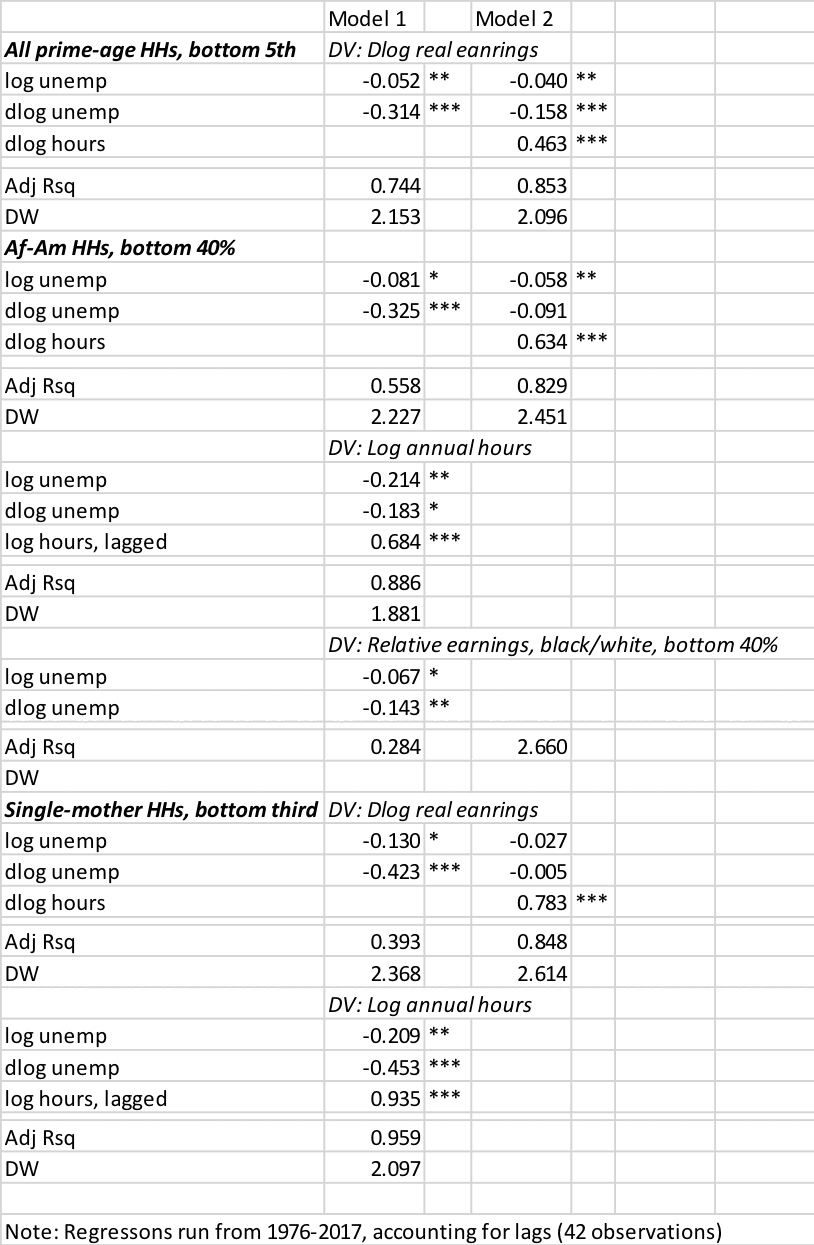
*, signif at 0.05 level; **, signif at 0.01 level; ***, signif at 0.001 level.
| TABLE A2 | ||||
|---|---|---|---|---|
| Panel Regressions of Prime-Age workers | ||||
|
Men |
DV: Log real annual earnings |
|||
|
Log unemp |
-0.034 |
*** |
-0.030 |
*** |
|
Log avg age |
0.238 |
* |
||
|
Share white |
-0.008 |
|||
|
Share in manufacturing |
0.145 |
*** |
||
|
Share union |
-0.111 |
* |
||
|
Avg education |
0.024 |
** |
||
|
AdjRsq |
0.095 |
0.099 |
||
|
DW |
2.737 |
2.733 |
||
|
Women |
||||
|
Log unemp |
-0.028 |
*** |
-0.023 |
** |
|
Log avg age |
0.407 |
*** |
||
|
Share white |
0.030 |
|||
|
Avg education |
0.048 |
*** |
||
|
AdjRsq |
0.065 |
0.076 |
||
|
DW |
2.777 |
2.763 |
||
Note: Regressions are on panel data of state/years from 1976 to 2017, yielding 2,091 observations with lags. Regressions include fixed effects and standard errors are clustered at the state level.
Real-Time Estimates of Potential GDP: Should the Fed Really Be Hitting the Brakes?
End Notes
[1] The authors thank David Mericle and Michael Carr for helpful comments. Some of the empirical work was developed in an earlier draft with Ben Spielberg. Kathleen Bryant provided valuable assistance. Bernstein is a senior fellow at the Center on Budget and Policy Priorities. Bentele is an associate professor of sociology at the University of Massachusetts Boston.
[2] Arthur M. Okun, “Upward Mobility in a High-Pressure Economy,” Brookings Institution, January 1973, https://www.brookings.edu/wp-content/uploads/1973/01/1973a_bpea_okun_fellner_greenspan.pdf.
[3] Nick Timiraos, “Federal Reserve Rate Projections Could Show Greater Confidence in Extended Pause,” The Wall Street Journal, March 17, 2019, https://www.wsj.com/articles/federal-reserve-rate-projections-could-show-greater-confidence-in-extended-pause-11552820400.
[4] Following Erceg et al, the equation uses annual data, 1959-2018, and regresses the log change in the core PCE on the u-gap and lagged inflation. For u*, we use CBOs estimate of the natural rate. The rolling regression uses 20-year windows.
[5] There are important nuances to consider in this context. First, while wage PCs typically measure nominal wage changes, our empirical work focuses on real changes. We also measure the impact of high-pressure labor markets on labor supply, and thus focus on changes in real earnings (real wages times hours) summed across households. This aspect of the benefits of high-pressure periods turns out to be economically important.
[6] We use annual values of the production, non-supervisory wage from the BLS Establishment Survey.
[7] Laurence M. Ball and Sandeep Mazumder, “The Non-puzzling Behavior of Median Inflation,” NBER Working Paper No. 25512, January 2019, https://www.nber.org/papers/w25512.
[8] Joe Gagnon, “There Is No Inflation Puzzle,” Peterson Institute for International Economics, November 17, 2017, https://piie.com/blogs/realtime-economic-issues-watch/there-no-inflation-puzzle.
[9] Daan Struyven, “US Daily: Will the Phillips Curve Bend or Break,” Goldman Sachs Research, October 2017.
[10] These are R-squareds from the second of a two-stage regression. In the first stage, we regress the log change in core PCE inflation on its lag. It the second stage, we regress the residuals from that regression on u-u*.
[11] Christopher Erceg et al., “Some Implications of Uncertainty and Misperception for Monetary Policy,” Federal Reserve Board of Governors: Finance and Economics Discussion Series, August 9, 2018, https://www.federalreserve.gov/econres/feds/files/2018059pap.pdf.
[12] Federal Open Market Committee, “Chairman’s FOMC Press Conference Projection Materials,” December 19, 2018, https://www.federalreserve.gov/monetarypolicy/files/fomcprojtabl20181219.pdf.
[13] Their table 3, rows 5 and 6, show that for u*=3.7 percent, the “welfare improvement share” is about the same for both cases.
[14] Lawrence F. Katz and Alan B. Krueger, “The High-Pressure US Labor Market of the 1990s,” Brookings Papers on Economic Activity, 1999(1), pp. 1-87, https://www.brookings.edu/wp-content/uploads/1999/01/1999a_bpea_katz.pdf.
[15] David Mericle and Avisha Thakkar, “What’s the Point of Running a High-Pressure Economy,” Goldman Sachs Research, October 2016.
[16] Jared Bernstein, “The Importance of Strong Labor Demand,” The Hamilton Project, February 2018, http://www.hamiltonproject.org/assets/files/importance_strong_labor_demand_bernstein_policy_proposal.pdf.
[17] Josh Bivens and Ben Zipperer, “The importance of locking in full employment for the long haul,” Economic Policy Institute, August 21, 2018, https://www.epi.org/publication/the-importance-of-locking-in-full-employment-for-the-long-haul/.
[18] Tomaz Cajner et al., “Racial Gaps in Labor Market Outcomes in the Last Four Decades and Over the Business Cycle,” Federal Reserve Board: Finance and Economics Discussion Series, June 12, 2017, https://www.federalreserve.gov/econres/feds/files/2017071pap.pdf.
[19] Sarah Flood et al., Integrated Public Use Microdata Series, Current Population Survey: Version 6.0 [dataset]. Minneapolis, MN: IPUMS, 2018. https://doi.org/10.18128/D030.V6.0.
[20] All estimates are based on questions asking respondents to report total annual income from all sources last year, total earnings (wage and salary income) last year, total weeks worked last year, and the usual number of hours a week worked last year for each member of the household. These factors were then summed at the level of households.
[21] Single mothers are identified as female household heads, whose marital status is "Married, spouse absent", separated, divorced, widowed, or “never married/single,” and who have one or more of their own children in the household.
[22] Barry T. Hirsch and David A. Macpherson, “Union Membership and Coverage Database from the Current Population Survey: Note,” Industrial and Labor Relations Review, Vol. 56, No. 2, January 2003, pp. 349-54 (updated annually at unionstats.com).
[23] To account for a large increase in the CPS topcode for earnings in 1995, we arbitrarily wedged in the 1995 jump over the prior ten years.
[24] Former Fed Chair Yellen uses these same two slack variables in the wage growth model from this paper: Janet Yellen, “Inflation, Uncertainty, and Monetary Policy,” presentation at “Prospects for Growth: Reassessing the Fundamentals” 59th Annual Meeting of the National Association for Business Economics, September 26, 2017, https://www.federalreserve.gov/newsevents/speech/files/yellen20170926a.pdf.
[25] Note that the predictions are “dynamic,” meaning we use predicted, versus actual, values in predicting log changes of dependent variables throughout the paper.
[26] Because annual earnings/annual hours=hourly wage, as the coefficient on the log change in annual hours approaches 1, this model converges to a regression of the household’s log change in the real hourly wage on unemployment.
[27] I.e.: -0.37 – (-0.20)/-0.37 = 46%.
[28] Rebecca Blank, “Why Were Poverty Rates So High in the 1980s,” NBER Working Paper No. 3878, October 1991, https://www.nber.org/papers/w3878.
[29] Some versions of the “balanced Taylor rule” put a coefficient of 2 on the u-gap and 1.5 on the inflation gap.
[30] Research suggests that the full employment labor market and the EITC expansion played the biggest role. While the 1996 law also boosted labor supply, its effects were short-lived and it left many people behind, some of whom fell into deeper poverty. Moreover, as the uniquely strong demand conditions of the 1990s faded, non-employment rates of low-income workers rose, regardless of family type, a result consistent with work requirements’ general ineffectiveness in driving employment and earnings. See: Robert Greenstein, “Evidence Contradicts Likely Assumptions Behind Forthcoming GOP Poverty Plan,” CBPP, June 6, 2016, https://www.cbpp.org/research/family-income-support/welfare-reform-and-the-safety-net; LaDonna Pavetti, “Work Requirements Don’t Cut Poverty, Evidence Shows,” CBPP, June 7, 2016, https://www.cbpp.org/research/poverty-and-inequality/work-requirements-dont-cut-poverty-evidence-shows.
[31] Of course, weaker labor demand would likely have led to a lower real hourly wage in these years.
[32] The earnings values are unweighted state averages across each year.
[33] Standard errors are clustered at the state level.
[34] It is, of course, relevant for earnings, inflation, and the Fed’s actions that productivity growth accelerated in those years.
[35] The coefficient on logged annual hours is 0.37 with a t-stat of 7.9.
[36] Janet Yellen, “Macroeconomic Research After the Crisis,” presentation at 60th annual economic conference sponsored by the Federal Reserve Bank of Boston, October 14, 2016, https://www.federalreserve.gov/newsevents/speech/yellen20161014a.htm.
[37] Danny Yagan, “Employment Hysteresis from the Great Recession,” NBER Working Paper No. 23844, September 2017, https://www.nber.org/papers/w23844.
[38] Ben Casselman, “Why Some Scars From the Recession May Never Vanish,” The New York Times, October 5, 2017, https://www.nytimes.com/2017/10/05/business/economy/recession-recovery.html.
[39] Laurence Ball, “Monetary Policy for a High-Pressure Economy,” CBPP, March 30, 2015, https://www.cbpp.org/research/full-employment/monetary-policy-for-a-high-pressure-economy.
[40] Thomas R. Michl and Kayla M. Oliver, “Combating hysteresis with output targeting,” Review of Keynesian Economics (Spring 2019), pp. 6-27, https://www.elgaronline.com/view/journals/roke/7-1/roke.2019.01.02.xml.
[41] Josh Bivens, “A ‘high-pressure economy’ can help boost productivity and provide even more ‘room to run’ for the recovery,” Economic Policy Institute, March 12, 2017, https://www.epi.org/publication/a-high-pressure-economy-can-help-boost-productivity-and-provide-even-more-room-to-run-for-the-recovery/.
[42] Mericle and Thakkar, 2016.
[43] As of this writing, some are claiming that there has, in fact, been a recent acceleration in productivity. I argue it is too soon to make this call: https://twitter.com/econjared/status/1125071587223453696.
[44] Janet Yellen, “The Economic Outlook and the Conduct of Monetary Policy,” presentation at Stanford Institute for Economic Policy Research, January 19, 2017, https://www.federalreserve.gov/newsevents/speech/yellen20170119a.htm.
[45] Jan Hatzius and David Mericle,“March FOMC Preview: Are We There Yet,” Goldman Sachs Research, March 2019.
More from the Authors

Areas of Expertise

Bentele is an associate research professor at the University of Arizona.
